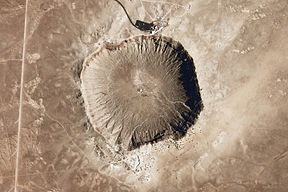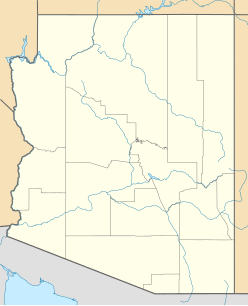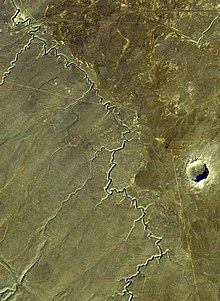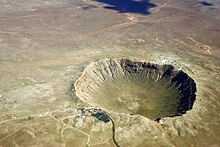Meteor Crater
From Wikipedia, the free encyclopedia
For meteorite-created craters in general, see Impact crater.
"Barringer Crater" redirects here. For the crater on the Moon, see Barringer (lunar crater).
| Meteor Crater | |
|---|---|
| Barringer Crater | |

Meteor Crater, also known as Barringer Crater
| |
| Impact crater/structure | |
| Confidence | Confirmed[1] |
| Diameter | 1.186 kilometers (0.737 mi) |
| Age | 50,000 years |
| Exposed | Yes |
| Drilled | Yes |
| Bolide type | Iron meteorite |
| Location | |
| Location | Coconino County, Arizona |
| Coordinates | 35°1′38″N 111°1′21″WCoordinates: 35°1′38″N 111°1′21″W |
| Country | United States |
| State | Arizona |
| Municipality | |
| Designated: | November 1967 |
| Access | Interstate 40 |
Meteor Crater is a meteorite impact crater approximately 43 miles (69 km) east of Flagstaff, near Winslow in the northern Arizonadesert of the United States. It is the largest impact crater yet discovered in the United States.[2] Because the United States Board on Geographic Names commonly recognizes names of natural features derived from the nearest post office, the feature acquired the name of "Meteor Crater" from the nearby post office named Meteor.[3] The site was formerly known as the Canyon Diablo Crater,[4]and fragments of the meteorite are officially called the Canyon Diablo Meteorite. Scientists refer to the crater as Barringer Crater in honor of Daniel Barringer, who was first to suggest that it was produced by meteorite impact.[5] The crater is privately owned by the Barringer family through their Barringer Crater Company,[6] which proclaims it to be "best preserved meteorite crater on Earth".[7]
Despite its importance as a geological site, the crater is not protected as a national monument, a status that would require federal ownership. It was designated a National Natural Landmark in November 1967.[8]
Meteor Crater lies at an elevation of about 1,740 m (5,710 ft) above sea level. It is about 1,200 m (3,900 ft) in diameter, some 170 m deep (570 ft), and is surrounded by a rim that rises 45 m (148 ft) above the surrounding plains. The center of the crater is filled with 210–240 m (690–790 ft) of rubble lying above crater bedrock.[1] One of the interesting features of the crater is its squared-off outline, believed to be caused by pre-existing regional jointing (cracks) in the strata at the impact site.[9]
Contents
[hide]Formation of the crater
The crater was created about 50,000 years ago[10][11] during the Pleistocene epoch when the local climate on the Colorado Plateauwas much cooler and damper. It is the world’s best preserved meteorite impact site.[12] At the time, the area was an open grassland dotted with woodlands inhabited by woolly mammoths and giant ground sloths.[citation needed] It was probably not inhabited by humans; the earliest confirmed record of human habitation in the Americas dates from long after this impact.[citation needed]
The object that excavated the crater was a nickel–iron meteorite about 50 meters (55 yards) across, which struck the plain at a speed of several kilometers per second. Impact energy has been estimated at about 10 megatons. The speed of the impact has been a subject of some debate. Modeling initially suggested that the meteorite struck at a speed of up to 20 kilometers per second (45,000 mph), but more recent research suggests the impact was substantially slower, at 12.8 kilometers per second (28,600 mph). It is believed that about half of the impactor's bulk was vaporized during its descent before it hit the ground.[13]
The meteorite itself was mostly vaporized upon impact, leaving little in the crater.[14]
Discovery and investigation
The crater came to the attention of scientists following its discovery by European settlers in the 19th century. Dubbed the Canyon Diablo crater – from Canyon Diablo, Arizona, the closest community to the crater in the late 19th century, 12 miles (19 km) northwest of the crater, but now a ghost town – it had initially been ascribed to the actions of a volcano. This was not an unreasonable assumption, as the San Francisco volcanic field lies only about 40 miles (64 km) to the west.[citation needed]
Grove Karl Gilbert
In 1891, Grove Karl Gilbert, chief geologist for the U.S. Geological Survey, investigated the crater and concluded that it was the result of a volcanic steam explosion. Gilbert had assumed that if it were an impact crater then the volume of the crater, as well as meteoritic material, should be present on the rim. Gilbert also assumed a large portion of the meteorite should be buried in the crater and that this would generate a large magnetic anomaly. Gilbert's calculations showed that the volume of the crater and the debris on the rim were roughly equivalent, so that the mass of the hypothetical impactor was missing, nor were there any magnetic anomalies. Gilbert argued that the meteorite fragments found on the rim were coincidental. Gilbert would publicize these conclusions in a series of lectures.[15] In 1892, Gilbert would be among the first to propose that the Moon's craters were caused by impact rather than volcanism.[16]
Daniel Barringer
In 1903, mining engineer and businessman Daniel M. Barringer suggested that the crater had been produced by the impact of a large iron-metallic meteorite. Barringer's company, the Standard Iron Company, staked a mining claim to the land[17] and received a land patent signed byTheodore Roosevelt[18] for 640 acres (2.6 km2) around the center of the crater in 1903.[19] The claim was divided into four quadrants coming from the center clockwise from northwest named Venus, Mars, Jupiter and Saturn. In 1906, Roosevelt authorized the establishment of a newly named Meteor, Arizona, post office (the closest post office before was 30 miles (48 km) away in Winslow, Arizona).[citation needed]
Standard Iron Company conducted research on the crater's origins between 1903 and 1905. It concluded that the crater had indeed been caused by an impact. Barringer and his partner, themathematician and physicist Benjamin Chew Tilghman, documented evidence for the impact theory in papers presented to the U.S. Geological Survey in 1906 and published in the Proceedings of the Academy of Natural Sciences in Philadelphia.[20]
Barringer's arguments were met with skepticism, as there was a reluctance at the time to consider the role of meteorites in terrestrial geology. He persisted and sought to bolster his theory by locating the remains of the meteorite. At the time of first discovery by Europeans, the surrounding plains were covered with about 30 tons of large oxidized iron meteorite fragments. This led Barringer to believe that the bulk of the impactor could still be found under the crater floor. Impact physics was poorly understood at the time and Barringer was unaware that most of the meteorite vaporized on impact. He spent 27 years trying to locate a large deposit of meteoric iron, and drilled to a depth of 419 m (1,375 ft), but no significant deposit was ever found.[citation needed]
Barringer, who in 1894 was one of the investors who made $15 million in the Commonwealth silver mine in Pearce, Cochise County, Arizona, had ambitious plans for the iron ore.[21] He estimated from the size of the crater that the meteorite had a mass of 100 million tons.[15] The current estimate of 300,000 tons for the impactor is only three-tenths of one percent of Barringer's estimate. Iron ore of the type found at the crater was valued at the time at $125/ton, so Barringer was searching for a lode he believed to be worth more than a billion 1903 dollars.[21]
Despite Barringer's findings and other excavations in the early 20th century,[22] geologists' skepticism continued until the 1950s when planetary science gained in maturity and understanding of cratering processes increased. Professor Herman Leroy Fairchild, an early promoter of impact cratering, argued Barringer's case in an article in Science in 1930.[13][23]
Eugene M. Shoemaker
It was not until 1960 that later research by Eugene Merle Shoemaker confirmed Barringer's hypothesis. The key discovery was the presence in the crater of the minerals coesite and stishovite, rare forms of silica found only where quartz-bearing rocks have been severely shocked by an instantaneous overpressure. It cannot be created by volcanic action; the only known mechanism of creating it is through an impact event (or artificially through a nuclear explosion).[24][25]
Shoemaker's discovery is considered the first definitive proof of an extraterrestrial impact on the Earth's surface. Since then, numerous impact craters have been identified around the world, though Meteor Crater remains one of the most visually impressive owing to its size, young age, and lack of vegetative cover.
Geology
The impact created an inverted stratigraphy, so that the layers immediately exterior to the rim are stacked in the reverse order to which they normally occur; the impact overturned and inverted the layers to a distance of one to two kilometers outward from the crater's edge.[26]Specifically, climbing the rim of the crater from outside, one finds:
- Coconino Sandstone (sandstone formed 265 million years ago) nearest the top of the rim
- Toroweap Formation (limestone formed 255 million years ago)
- Kaibab Formation (dolomite formed 250 million years ago)
- Moenkopi Formation (mudstone formed 245 million years ago) nearest the outer foot of the rim
Meteor Crater today
Meteor Crater is today a popular tourist attraction privately owned by the Barringer family through the Barringer Crater Company, with an admission fee charged to see the crater. The Meteor Crater Visitor Center on the north rim features interactive exhibits and displays aboutmeteorites and asteroids, space, the solar system and comets. It features the American Astronaut Wall of Fame, and such artifacts on display as an Apollo boilerplate command module (BP-29), a 1,406 pound meteorite found in the area, and meteorite specimens from Meteor Crater that can be touched. Formerly known as the Museum of Astrogeology, the Visitor Center includes a movie theater, a gift shop, and observation areas with views inside the rim of the crater. Guided tours of the rim are offered daily.











No comments:
Post a Comment